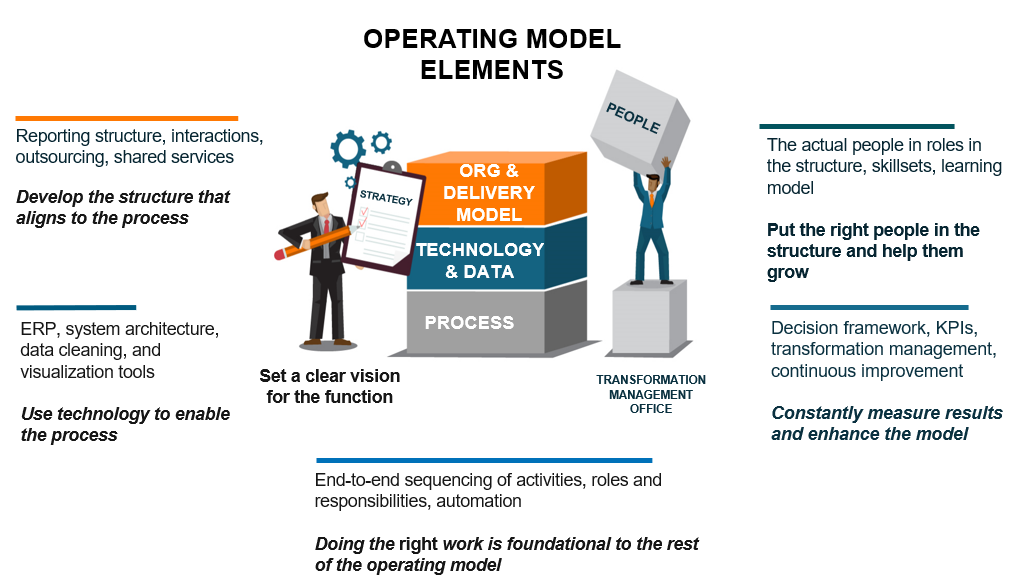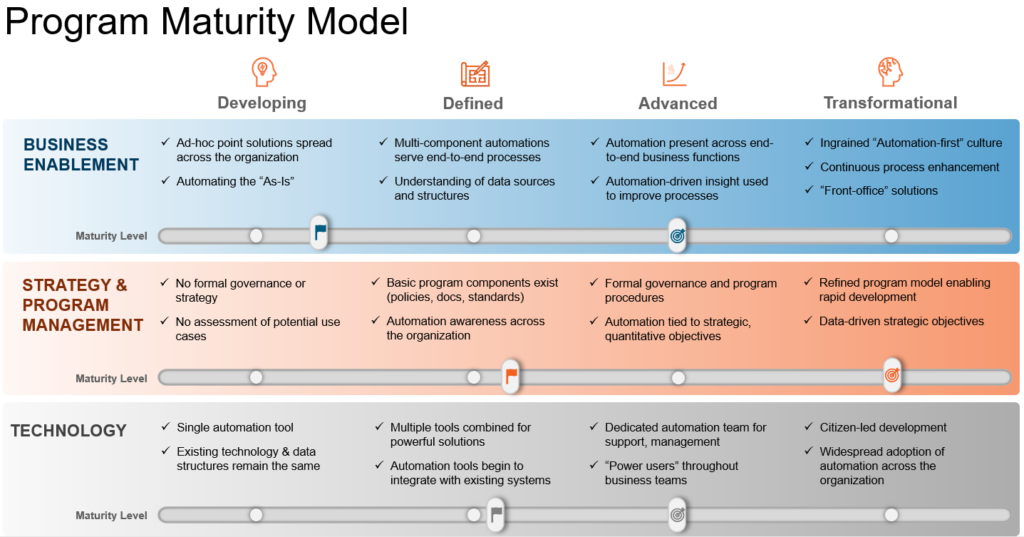As automation investments skyrocket – projected to more than triple in the next decade – the mantra “Never automate a bad process” rings even truer.
When launching an automation program – often beginning with a specific process or function before being deployed more holistically across the organization – leaders must consider that optimization must also justifiably occur before any automation engineering. That means optimizing process workflows, standing up stronger governance structures, implementing enforceable controls, and generally taking a long-term, holistic view of the operating model. This is all to ensure you’re doing the right automation work, not just the easiest, fastest, or most obvious.
In fact, companies that invest in transformation holistically see approximately 80% success rates while a partial or siloed approach to transformation yields just 30%.
Taking steps of these kinds also ensures there’s a high level of human intent involved from the start. End users – and those tasked with best enabling those users – desire thoughtful, impactful tools and processes that generate objectively better outcomes for them, be it the speed at which they work, satisfaction in their role or with user experience, or time returned to focus on value-add activities.
Human-centered design is foundational to producing and inspiring these outcomes, especially when embarking on automation programs that already engender complicated feelings about job insecurity, displacement, and learning curves. Human-centered design moves the needle across the core tenets of transformation: people, process, data, and technology. By applying these design principles, organizations can create user-centric solutions, foster adoption, and cultivate a future-ready and satisfied workforce.
Understand the Operating Model
For automation to achieve its full potential, it requires more than a few successful but narrow deployments. It needs wider context and utility to ensure it’s scalable to additional use cases and functions. In the image below, transforming the finance department through automation must account for more than the individual processes of Record-to-Report, Quote-to-Cash, or Hire-to-Retire, for instance.

Human-centered design factors in the entire human experience: the actual staff doing the work, their respective skill sets, the existing technologies they use, their management frameworks, their communication preferences, and so forth. Getting the operating model right is imperative to automation success. The lens of human-centered design helps make this happen.
Establish a Center of Excellence
Without strategy and governance – as outlined by a transformation roadmap to achieve them – automation programs have the penchant for becoming mere side projects with limited impact. They’re shiny toys used by small teams but with finite value for other functions.
A Center of Excellence (CoE) ensures automation is driver-based and fully accountable. This includes not only key stakeholders sitting in the right seats but, more importantly, a holistic, actionable strategy that’s clear to everyone involved from day one supported by educational materials, intake assessments, transformation management offices, and more. The CoE should implement guardrails, not handcuffs during the design process.
It’s not uncommon for automation to generate 6X ROI when successfully executed and adopted through a CoE. It’s equally common, unfortunately, that a rudderless automation program intended for one function (e.g. Finance) is wrestled away by another (e.g. IT) because no strategy, ownership, and governance are established.
Define the Steering Committee
Within the CoE, the steering committee plays a particularly imperative role. Without an effective steering committee, several things tend to happen, including but not limited to:
- Poor prioritization.
- Sub-optimal sourcing of meaningful projects.
- Misalignment between functions, stakeholders, and business objectives.
Steering committees with more experience in automation, including the specific automation platforms under consideration like Alteryx or UiPath, can help spot and predict efficiencies to be gained, investments to be made, and outcomes on which to be hyper-focused before, during, and after the initiative. They can define and then drive toward success with clear progress milestones, reinforcement, and buy-in across all functions.
Baseline Against a Maturity Model
All progress begins with what you can measure. An automation program maturity model thus plots the organization’s current and target states on a spectrum for all to see, serving as a consistent point of reference as realities on the ground evolve and leaders begin to proactively look into the future at scalability potential outside existing or known requirements.

It’s also important to have sub-KPIs and OKRs for individual teams or processes that ladder up to high-level goals. This allows each category in the above illustration, for example, to be broken down into granular scoring matrices that are achievable and direct. As micro-teams work on their specific project work under the umbrella of the automation initiative, they collectively move as one unit that advances progress on the high-level OKRs.
Applying the Human-Centered Design Framework
Scaling an automation program can only be successful when the delivery and experience of the program are enjoyable to users. A bad automation quickly turns negative; a good automation improperly communicated can also turn negative. A human-centered approach avoids both outcomes.
A lack of adoption commonly plagues technical rollouts, including data projects. It’s estimated that 77% of big data and artificial intelligence (AI) initiatives have trouble being adopted. 85% of data projects fail – never making it past preliminary stages. And yet, 92% of firms seek to increase investment in data and analytics.
They see the prize but lack the framework to achieve it.
To keep users’ desires, pain points, and preferences front of mind, it’s important to leverage the following human-centered design framework:
1. Inspiration and Empathy
In the first phase of human-centered design, the goal is to do a discovery and intake process. What do people actually want? How would they feel about a change? What needs to be done to increase job satisfaction?
2. Ideation and Exploration
The second phase entails brainstorming, prototyping, testing, and iterating. This is where a minimum viable product (MVP) is developed based on user requirements. The goal is not to create the perfect solution on the first pass, as it’s critical to get continuous user feedback at multiple stages of the development lifecycle to ensure the product and the design framework are still attuned to human needs.
3. Implementation and Exploration
In the final phase of development, the CoE becomes even more vital. This is the time when the MVP is released and socialized to the business. The CoE should use this pilot stage to solicit more feedback, refine design parameters, define success metrics, and ensure the product is iterated on further on a smaller scale. Buy-in can only be achieved when users and non-users fully understand the benefits and functionality of a tool, so the technical engineering language needs to segue into more business-friendly terminology that larger groups of people can grasp.
After using a human-centered design framework for automation and other data programs, the successes generated can be rolled into new initiatives in other functions, while the challenges discovered along the way can be planned for and ironed out in advance, creating a culture of continuous improvement across the organization.
For expert support on your next automation initiative, contact CrossCountry Consulting.